Internal Audit and Management of Compliance Risk Analysis
VerifiedAdded on 2022/08/13
|17
|3828
|12
Report
AI Summary
This report provides a critical analysis of four journal articles focusing on internal audit and its importance in risk management and compliance within the modern business environment. The report examines the role of internal auditors, the significance of adhering to Internal Auditing Standards, the impact of ethical codes, and the application of the Three Lines of Defense model. It delves into the research problems, questions, and hypotheses presented in each article, along with the underlying theoretical frameworks, key motivating literature, and research methods employed. The analysis covers the selection of samples, the importance of the articles, and how the research contributes to the field of internal audit. The articles discuss the importance of internal audit in various countries and its effect on the organization, including the effectiveness of audit, the role of internal auditors, and their relationships with management and financial reporting risks. This comprehensive review offers insights into the evolving landscape of internal audit and its impact on corporate governance and risk management.
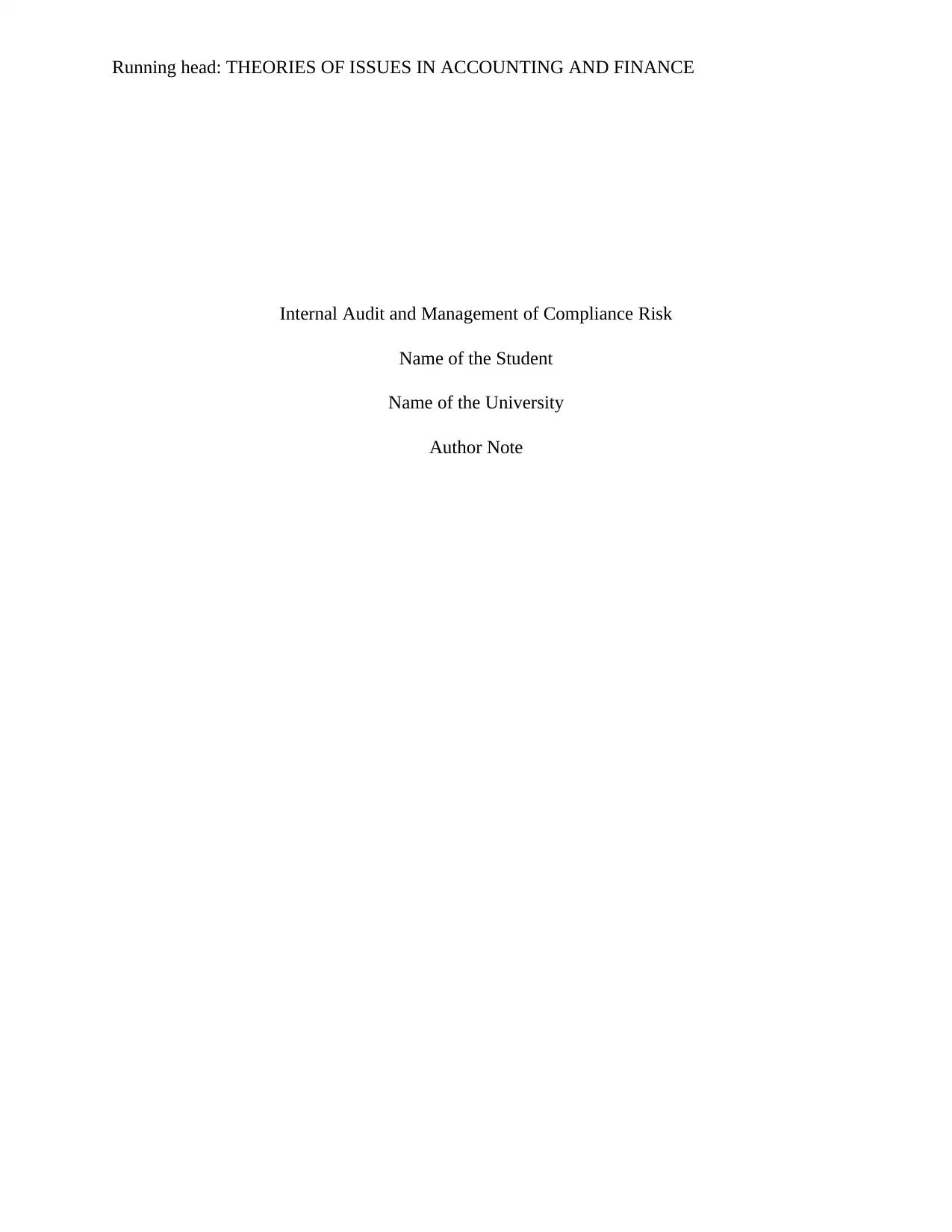
Running head: THEORIES OF ISSUES IN ACCOUNTING AND FINANCE
Internal Audit and Management of Compliance Risk
Name of the Student
Name of the University
Author Note
Internal Audit and Management of Compliance Risk
Name of the Student
Name of the University
Author Note
Paraphrase This Document
Need a fresh take? Get an instant paraphrase of this document with our AI Paraphraser
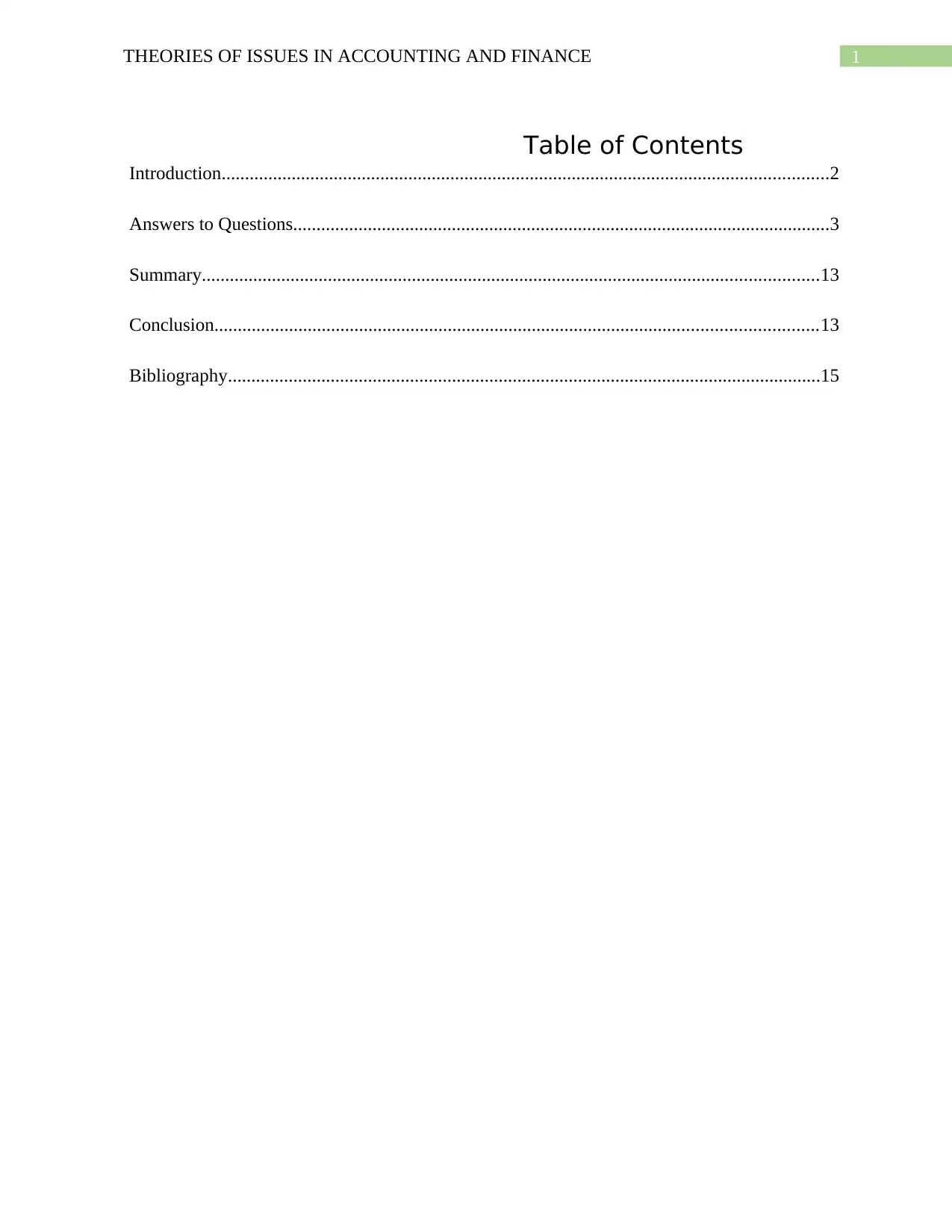
1THEORIES OF ISSUES IN ACCOUNTING AND FINANCE
Table of Contents
Introduction..................................................................................................................................2
Answers to Questions...................................................................................................................3
Summary....................................................................................................................................13
Conclusion.................................................................................................................................13
Bibliography...............................................................................................................................15
Table of Contents
Introduction..................................................................................................................................2
Answers to Questions...................................................................................................................3
Summary....................................................................................................................................13
Conclusion.................................................................................................................................13
Bibliography...............................................................................................................................15
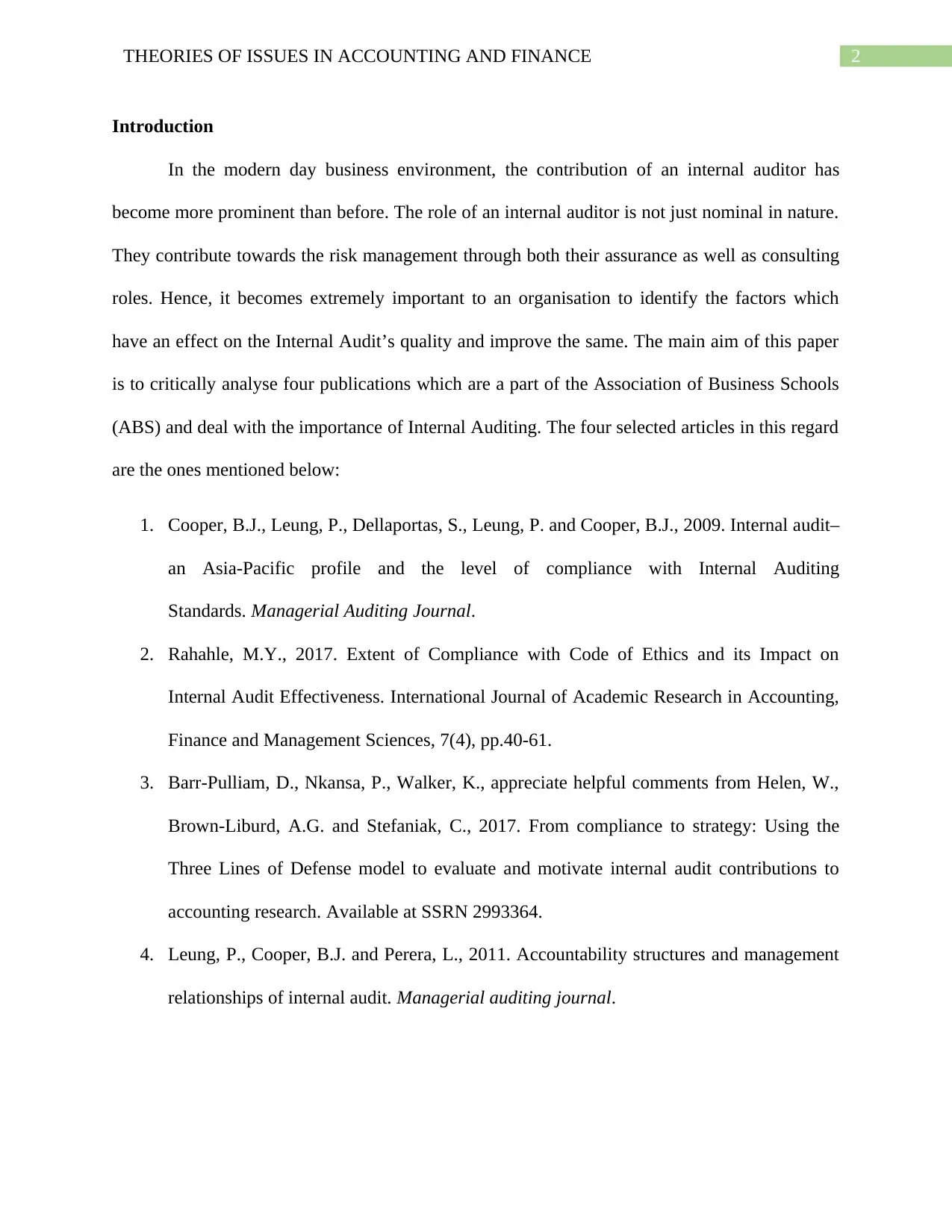
2THEORIES OF ISSUES IN ACCOUNTING AND FINANCE
Introduction
In the modern day business environment, the contribution of an internal auditor has
become more prominent than before. The role of an internal auditor is not just nominal in nature.
They contribute towards the risk management through both their assurance as well as consulting
roles. Hence, it becomes extremely important to an organisation to identify the factors which
have an effect on the Internal Audit’s quality and improve the same. The main aim of this paper
is to critically analyse four publications which are a part of the Association of Business Schools
(ABS) and deal with the importance of Internal Auditing. The four selected articles in this regard
are the ones mentioned below:
1. Cooper, B.J., Leung, P., Dellaportas, S., Leung, P. and Cooper, B.J., 2009. Internal audit–
an Asia‐Pacific profile and the level of compliance with Internal Auditing
Standards. Managerial Auditing Journal.
2. Rahahle, M.Y., 2017. Extent of Compliance with Code of Ethics and its Impact on
Internal Audit Effectiveness. International Journal of Academic Research in Accounting,
Finance and Management Sciences, 7(4), pp.40-61.
3. Barr-Pulliam, D., Nkansa, P., Walker, K., appreciate helpful comments from Helen, W.,
Brown-Liburd, A.G. and Stefaniak, C., 2017. From compliance to strategy: Using the
Three Lines of Defense model to evaluate and motivate internal audit contributions to
accounting research. Available at SSRN 2993364.
4. Leung, P., Cooper, B.J. and Perera, L., 2011. Accountability structures and management
relationships of internal audit. Managerial auditing journal.
Introduction
In the modern day business environment, the contribution of an internal auditor has
become more prominent than before. The role of an internal auditor is not just nominal in nature.
They contribute towards the risk management through both their assurance as well as consulting
roles. Hence, it becomes extremely important to an organisation to identify the factors which
have an effect on the Internal Audit’s quality and improve the same. The main aim of this paper
is to critically analyse four publications which are a part of the Association of Business Schools
(ABS) and deal with the importance of Internal Auditing. The four selected articles in this regard
are the ones mentioned below:
1. Cooper, B.J., Leung, P., Dellaportas, S., Leung, P. and Cooper, B.J., 2009. Internal audit–
an Asia‐Pacific profile and the level of compliance with Internal Auditing
Standards. Managerial Auditing Journal.
2. Rahahle, M.Y., 2017. Extent of Compliance with Code of Ethics and its Impact on
Internal Audit Effectiveness. International Journal of Academic Research in Accounting,
Finance and Management Sciences, 7(4), pp.40-61.
3. Barr-Pulliam, D., Nkansa, P., Walker, K., appreciate helpful comments from Helen, W.,
Brown-Liburd, A.G. and Stefaniak, C., 2017. From compliance to strategy: Using the
Three Lines of Defense model to evaluate and motivate internal audit contributions to
accounting research. Available at SSRN 2993364.
4. Leung, P., Cooper, B.J. and Perera, L., 2011. Accountability structures and management
relationships of internal audit. Managerial auditing journal.
⊘ This is a preview!⊘
Do you want full access?
Subscribe today to unlock all pages.

Trusted by 1+ million students worldwide
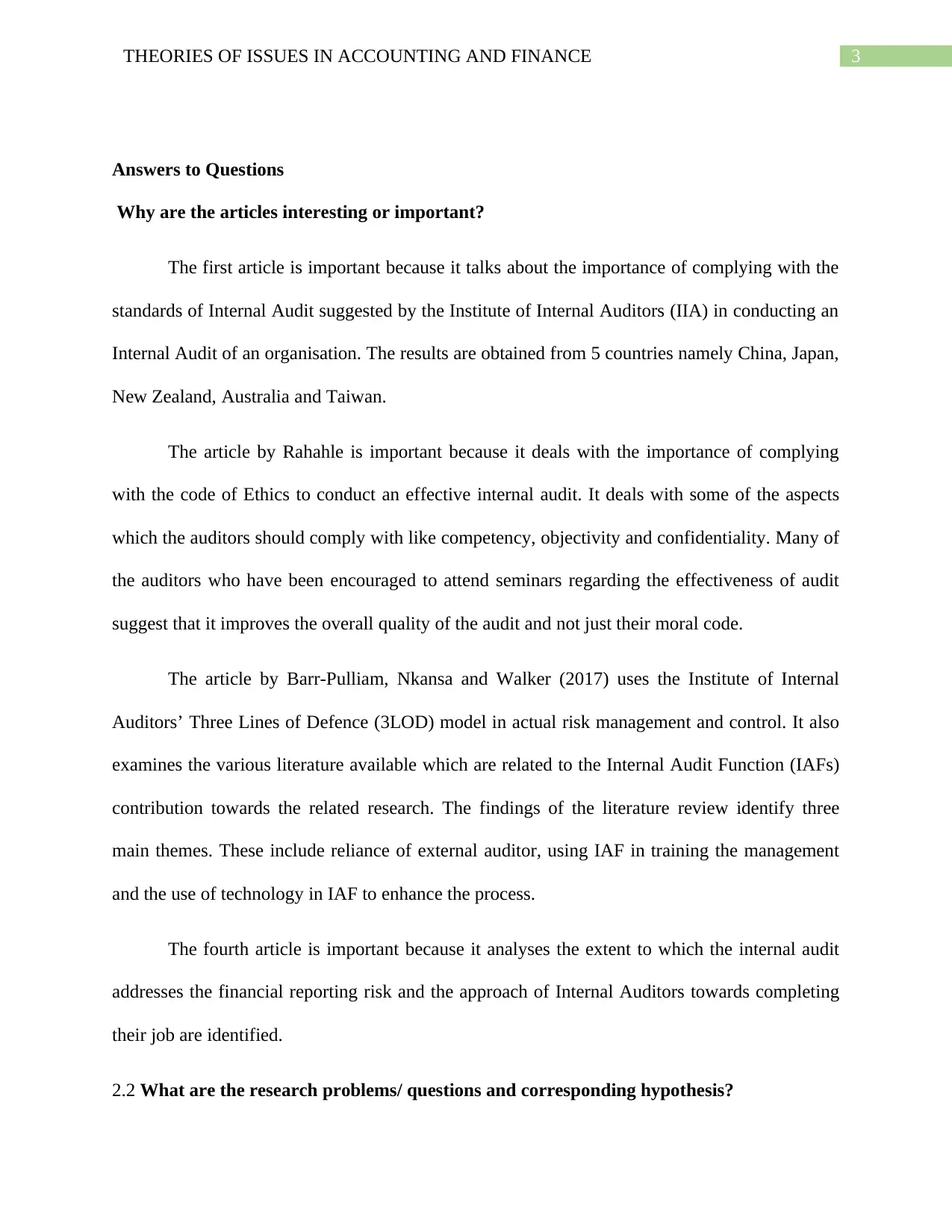
3THEORIES OF ISSUES IN ACCOUNTING AND FINANCE
Answers to Questions
Why are the articles interesting or important?
The first article is important because it talks about the importance of complying with the
standards of Internal Audit suggested by the Institute of Internal Auditors (IIA) in conducting an
Internal Audit of an organisation. The results are obtained from 5 countries namely China, Japan,
New Zealand, Australia and Taiwan.
The article by Rahahle is important because it deals with the importance of complying
with the code of Ethics to conduct an effective internal audit. It deals with some of the aspects
which the auditors should comply with like competency, objectivity and confidentiality. Many of
the auditors who have been encouraged to attend seminars regarding the effectiveness of audit
suggest that it improves the overall quality of the audit and not just their moral code.
The article by Barr-Pulliam, Nkansa and Walker (2017) uses the Institute of Internal
Auditors’ Three Lines of Defence (3LOD) model in actual risk management and control. It also
examines the various literature available which are related to the Internal Audit Function (IAFs)
contribution towards the related research. The findings of the literature review identify three
main themes. These include reliance of external auditor, using IAF in training the management
and the use of technology in IAF to enhance the process.
The fourth article is important because it analyses the extent to which the internal audit
addresses the financial reporting risk and the approach of Internal Auditors towards completing
their job are identified.
2.2 What are the research problems/ questions and corresponding hypothesis?
Answers to Questions
Why are the articles interesting or important?
The first article is important because it talks about the importance of complying with the
standards of Internal Audit suggested by the Institute of Internal Auditors (IIA) in conducting an
Internal Audit of an organisation. The results are obtained from 5 countries namely China, Japan,
New Zealand, Australia and Taiwan.
The article by Rahahle is important because it deals with the importance of complying
with the code of Ethics to conduct an effective internal audit. It deals with some of the aspects
which the auditors should comply with like competency, objectivity and confidentiality. Many of
the auditors who have been encouraged to attend seminars regarding the effectiveness of audit
suggest that it improves the overall quality of the audit and not just their moral code.
The article by Barr-Pulliam, Nkansa and Walker (2017) uses the Institute of Internal
Auditors’ Three Lines of Defence (3LOD) model in actual risk management and control. It also
examines the various literature available which are related to the Internal Audit Function (IAFs)
contribution towards the related research. The findings of the literature review identify three
main themes. These include reliance of external auditor, using IAF in training the management
and the use of technology in IAF to enhance the process.
The fourth article is important because it analyses the extent to which the internal audit
addresses the financial reporting risk and the approach of Internal Auditors towards completing
their job are identified.
2.2 What are the research problems/ questions and corresponding hypothesis?
Paraphrase This Document
Need a fresh take? Get an instant paraphrase of this document with our AI Paraphraser
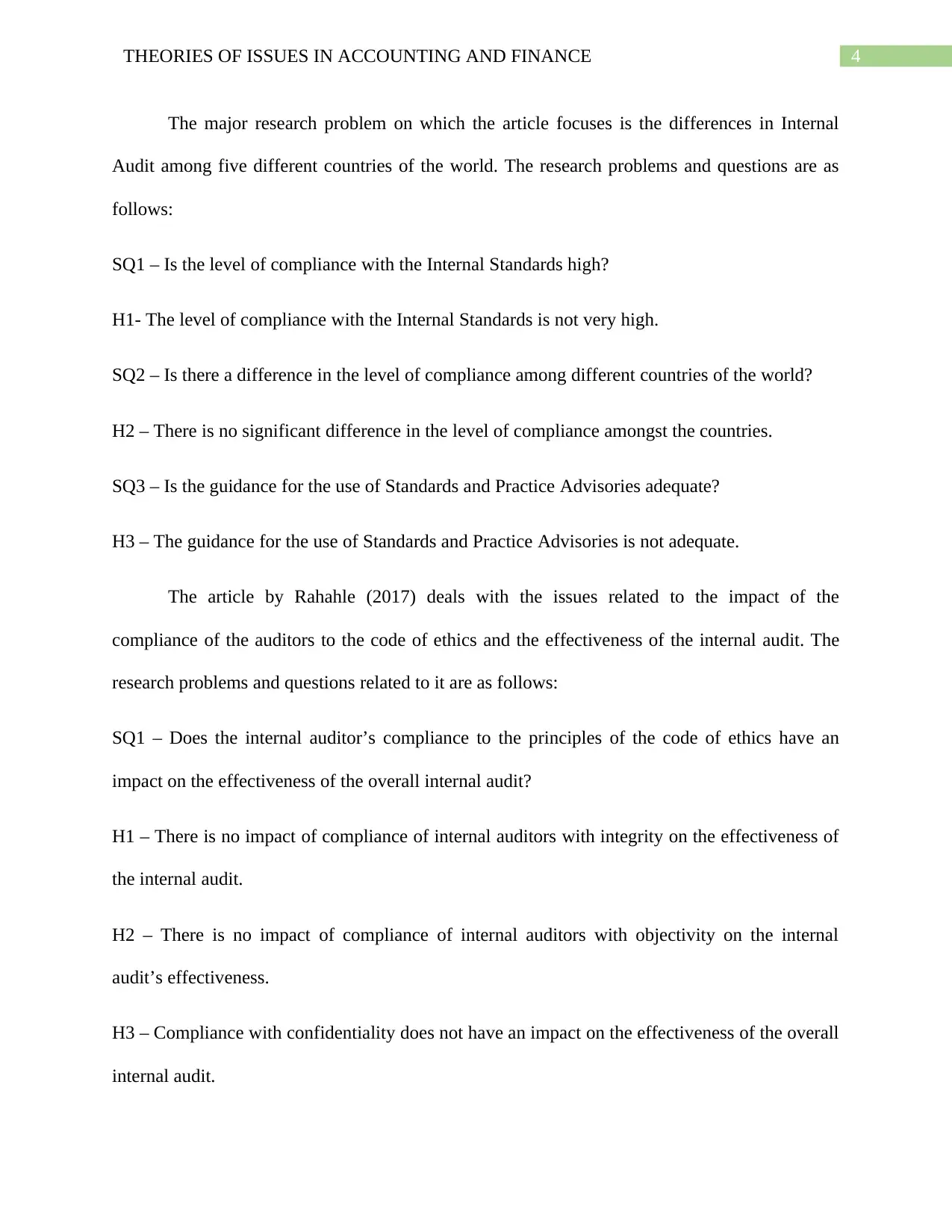
4THEORIES OF ISSUES IN ACCOUNTING AND FINANCE
The major research problem on which the article focuses is the differences in Internal
Audit among five different countries of the world. The research problems and questions are as
follows:
SQ1 – Is the level of compliance with the Internal Standards high?
H1- The level of compliance with the Internal Standards is not very high.
SQ2 – Is there a difference in the level of compliance among different countries of the world?
H2 – There is no significant difference in the level of compliance amongst the countries.
SQ3 – Is the guidance for the use of Standards and Practice Advisories adequate?
H3 – The guidance for the use of Standards and Practice Advisories is not adequate.
The article by Rahahle (2017) deals with the issues related to the impact of the
compliance of the auditors to the code of ethics and the effectiveness of the internal audit. The
research problems and questions related to it are as follows:
SQ1 – Does the internal auditor’s compliance to the principles of the code of ethics have an
impact on the effectiveness of the overall internal audit?
H1 – There is no impact of compliance of internal auditors with integrity on the effectiveness of
the internal audit.
H2 – There is no impact of compliance of internal auditors with objectivity on the internal
audit’s effectiveness.
H3 – Compliance with confidentiality does not have an impact on the effectiveness of the overall
internal audit.
The major research problem on which the article focuses is the differences in Internal
Audit among five different countries of the world. The research problems and questions are as
follows:
SQ1 – Is the level of compliance with the Internal Standards high?
H1- The level of compliance with the Internal Standards is not very high.
SQ2 – Is there a difference in the level of compliance among different countries of the world?
H2 – There is no significant difference in the level of compliance amongst the countries.
SQ3 – Is the guidance for the use of Standards and Practice Advisories adequate?
H3 – The guidance for the use of Standards and Practice Advisories is not adequate.
The article by Rahahle (2017) deals with the issues related to the impact of the
compliance of the auditors to the code of ethics and the effectiveness of the internal audit. The
research problems and questions related to it are as follows:
SQ1 – Does the internal auditor’s compliance to the principles of the code of ethics have an
impact on the effectiveness of the overall internal audit?
H1 – There is no impact of compliance of internal auditors with integrity on the effectiveness of
the internal audit.
H2 – There is no impact of compliance of internal auditors with objectivity on the internal
audit’s effectiveness.
H3 – Compliance with confidentiality does not have an impact on the effectiveness of the overall
internal audit.
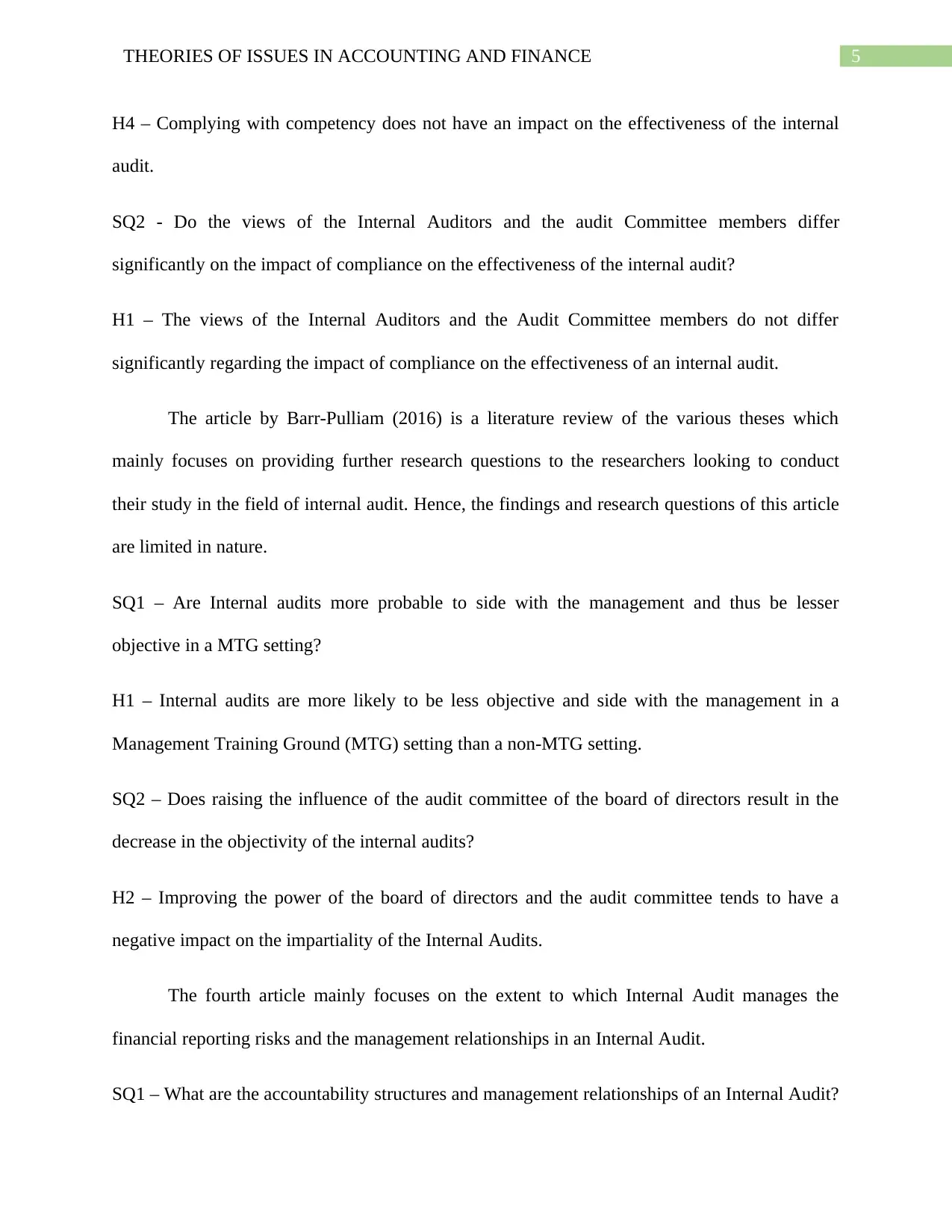
5THEORIES OF ISSUES IN ACCOUNTING AND FINANCE
H4 – Complying with competency does not have an impact on the effectiveness of the internal
audit.
SQ2 - Do the views of the Internal Auditors and the audit Committee members differ
significantly on the impact of compliance on the effectiveness of the internal audit?
H1 – The views of the Internal Auditors and the Audit Committee members do not differ
significantly regarding the impact of compliance on the effectiveness of an internal audit.
The article by Barr-Pulliam (2016) is a literature review of the various theses which
mainly focuses on providing further research questions to the researchers looking to conduct
their study in the field of internal audit. Hence, the findings and research questions of this article
are limited in nature.
SQ1 – Are Internal audits more probable to side with the management and thus be lesser
objective in a MTG setting?
H1 – Internal audits are more likely to be less objective and side with the management in a
Management Training Ground (MTG) setting than a non-MTG setting.
SQ2 – Does raising the influence of the audit committee of the board of directors result in the
decrease in the objectivity of the internal audits?
H2 – Improving the power of the board of directors and the audit committee tends to have a
negative impact on the impartiality of the Internal Audits.
The fourth article mainly focuses on the extent to which Internal Audit manages the
financial reporting risks and the management relationships in an Internal Audit.
SQ1 – What are the accountability structures and management relationships of an Internal Audit?
H4 – Complying with competency does not have an impact on the effectiveness of the internal
audit.
SQ2 - Do the views of the Internal Auditors and the audit Committee members differ
significantly on the impact of compliance on the effectiveness of the internal audit?
H1 – The views of the Internal Auditors and the Audit Committee members do not differ
significantly regarding the impact of compliance on the effectiveness of an internal audit.
The article by Barr-Pulliam (2016) is a literature review of the various theses which
mainly focuses on providing further research questions to the researchers looking to conduct
their study in the field of internal audit. Hence, the findings and research questions of this article
are limited in nature.
SQ1 – Are Internal audits more probable to side with the management and thus be lesser
objective in a MTG setting?
H1 – Internal audits are more likely to be less objective and side with the management in a
Management Training Ground (MTG) setting than a non-MTG setting.
SQ2 – Does raising the influence of the audit committee of the board of directors result in the
decrease in the objectivity of the internal audits?
H2 – Improving the power of the board of directors and the audit committee tends to have a
negative impact on the impartiality of the Internal Audits.
The fourth article mainly focuses on the extent to which Internal Audit manages the
financial reporting risks and the management relationships in an Internal Audit.
SQ1 – What are the accountability structures and management relationships of an Internal Audit?
⊘ This is a preview!⊘
Do you want full access?
Subscribe today to unlock all pages.

Trusted by 1+ million students worldwide
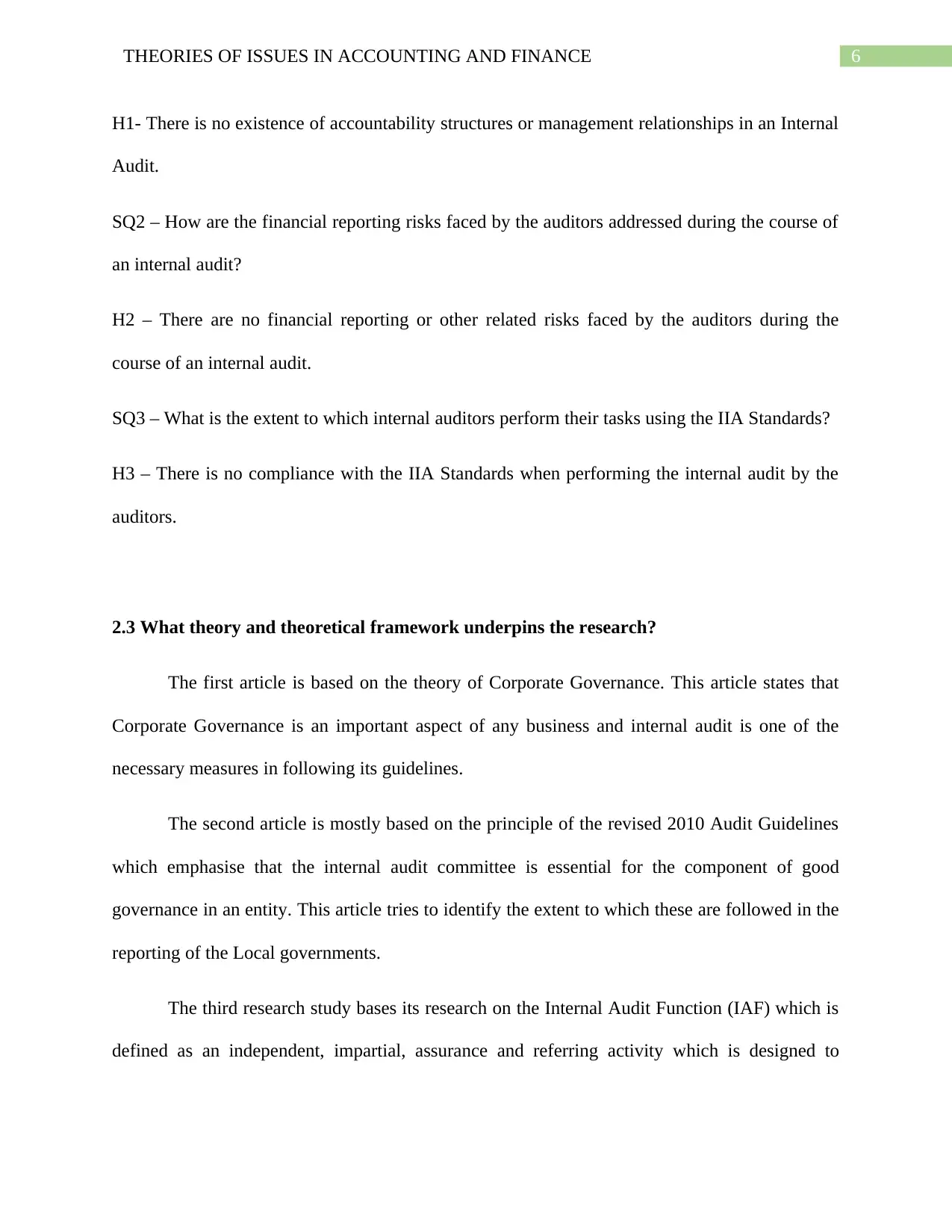
6THEORIES OF ISSUES IN ACCOUNTING AND FINANCE
H1- There is no existence of accountability structures or management relationships in an Internal
Audit.
SQ2 – How are the financial reporting risks faced by the auditors addressed during the course of
an internal audit?
H2 – There are no financial reporting or other related risks faced by the auditors during the
course of an internal audit.
SQ3 – What is the extent to which internal auditors perform their tasks using the IIA Standards?
H3 – There is no compliance with the IIA Standards when performing the internal audit by the
auditors.
2.3 What theory and theoretical framework underpins the research?
The first article is based on the theory of Corporate Governance. This article states that
Corporate Governance is an important aspect of any business and internal audit is one of the
necessary measures in following its guidelines.
The second article is mostly based on the principle of the revised 2010 Audit Guidelines
which emphasise that the internal audit committee is essential for the component of good
governance in an entity. This article tries to identify the extent to which these are followed in the
reporting of the Local governments.
The third research study bases its research on the Internal Audit Function (IAF) which is
defined as an independent, impartial, assurance and referring activity which is designed to
H1- There is no existence of accountability structures or management relationships in an Internal
Audit.
SQ2 – How are the financial reporting risks faced by the auditors addressed during the course of
an internal audit?
H2 – There are no financial reporting or other related risks faced by the auditors during the
course of an internal audit.
SQ3 – What is the extent to which internal auditors perform their tasks using the IIA Standards?
H3 – There is no compliance with the IIA Standards when performing the internal audit by the
auditors.
2.3 What theory and theoretical framework underpins the research?
The first article is based on the theory of Corporate Governance. This article states that
Corporate Governance is an important aspect of any business and internal audit is one of the
necessary measures in following its guidelines.
The second article is mostly based on the principle of the revised 2010 Audit Guidelines
which emphasise that the internal audit committee is essential for the component of good
governance in an entity. This article tries to identify the extent to which these are followed in the
reporting of the Local governments.
The third research study bases its research on the Internal Audit Function (IAF) which is
defined as an independent, impartial, assurance and referring activity which is designed to
Paraphrase This Document
Need a fresh take? Get an instant paraphrase of this document with our AI Paraphraser
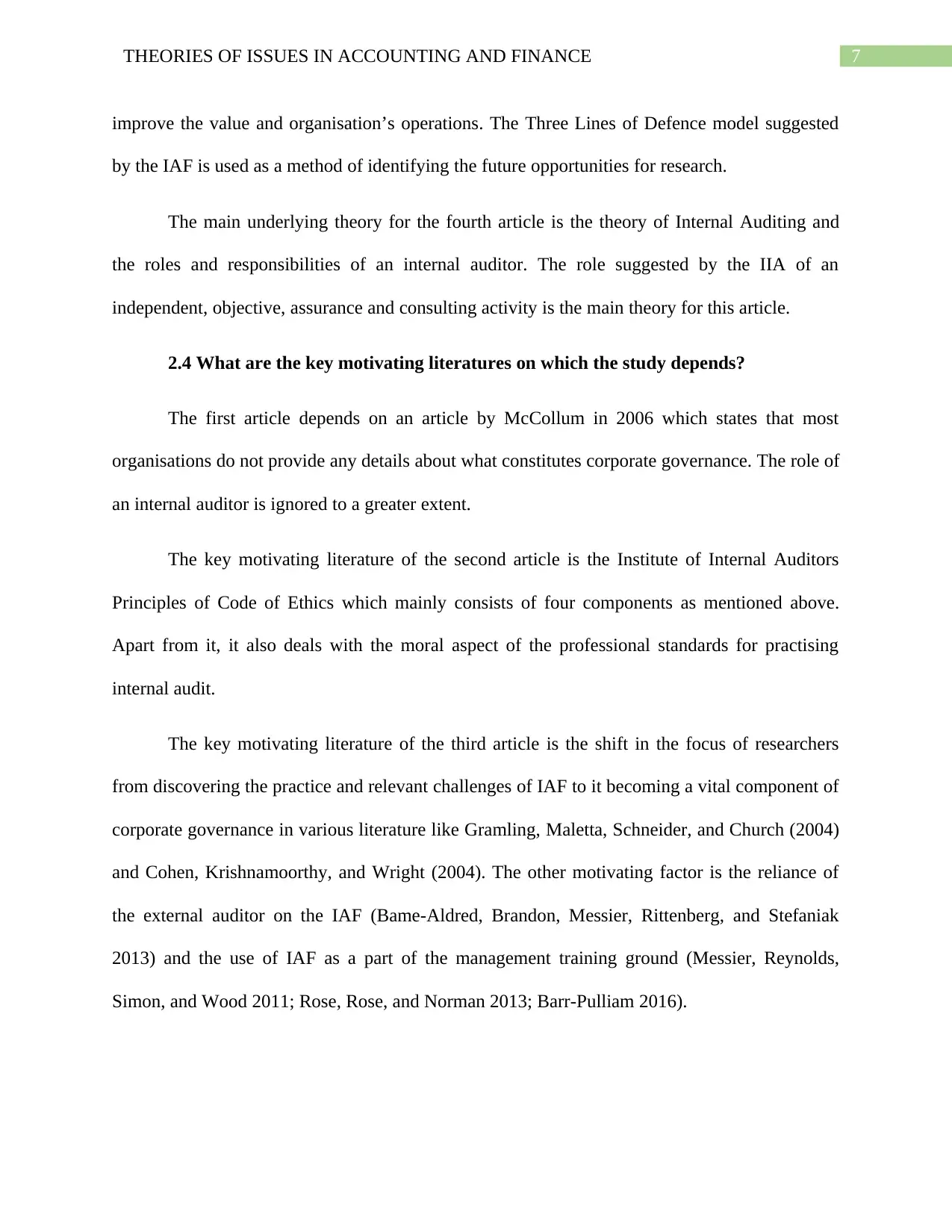
7THEORIES OF ISSUES IN ACCOUNTING AND FINANCE
improve the value and organisation’s operations. The Three Lines of Defence model suggested
by the IAF is used as a method of identifying the future opportunities for research.
The main underlying theory for the fourth article is the theory of Internal Auditing and
the roles and responsibilities of an internal auditor. The role suggested by the IIA of an
independent, objective, assurance and consulting activity is the main theory for this article.
2.4 What are the key motivating literatures on which the study depends?
The first article depends on an article by McCollum in 2006 which states that most
organisations do not provide any details about what constitutes corporate governance. The role of
an internal auditor is ignored to a greater extent.
The key motivating literature of the second article is the Institute of Internal Auditors
Principles of Code of Ethics which mainly consists of four components as mentioned above.
Apart from it, it also deals with the moral aspect of the professional standards for practising
internal audit.
The key motivating literature of the third article is the shift in the focus of researchers
from discovering the practice and relevant challenges of IAF to it becoming a vital component of
corporate governance in various literature like Gramling, Maletta, Schneider, and Church (2004)
and Cohen, Krishnamoorthy, and Wright (2004). The other motivating factor is the reliance of
the external auditor on the IAF (Bame-Aldred, Brandon, Messier, Rittenberg, and Stefaniak
2013) and the use of IAF as a part of the management training ground (Messier, Reynolds,
Simon, and Wood 2011; Rose, Rose, and Norman 2013; Barr-Pulliam 2016).
improve the value and organisation’s operations. The Three Lines of Defence model suggested
by the IAF is used as a method of identifying the future opportunities for research.
The main underlying theory for the fourth article is the theory of Internal Auditing and
the roles and responsibilities of an internal auditor. The role suggested by the IIA of an
independent, objective, assurance and consulting activity is the main theory for this article.
2.4 What are the key motivating literatures on which the study depends?
The first article depends on an article by McCollum in 2006 which states that most
organisations do not provide any details about what constitutes corporate governance. The role of
an internal auditor is ignored to a greater extent.
The key motivating literature of the second article is the Institute of Internal Auditors
Principles of Code of Ethics which mainly consists of four components as mentioned above.
Apart from it, it also deals with the moral aspect of the professional standards for practising
internal audit.
The key motivating literature of the third article is the shift in the focus of researchers
from discovering the practice and relevant challenges of IAF to it becoming a vital component of
corporate governance in various literature like Gramling, Maletta, Schneider, and Church (2004)
and Cohen, Krishnamoorthy, and Wright (2004). The other motivating factor is the reliance of
the external auditor on the IAF (Bame-Aldred, Brandon, Messier, Rittenberg, and Stefaniak
2013) and the use of IAF as a part of the management training ground (Messier, Reynolds,
Simon, and Wood 2011; Rose, Rose, and Norman 2013; Barr-Pulliam 2016).
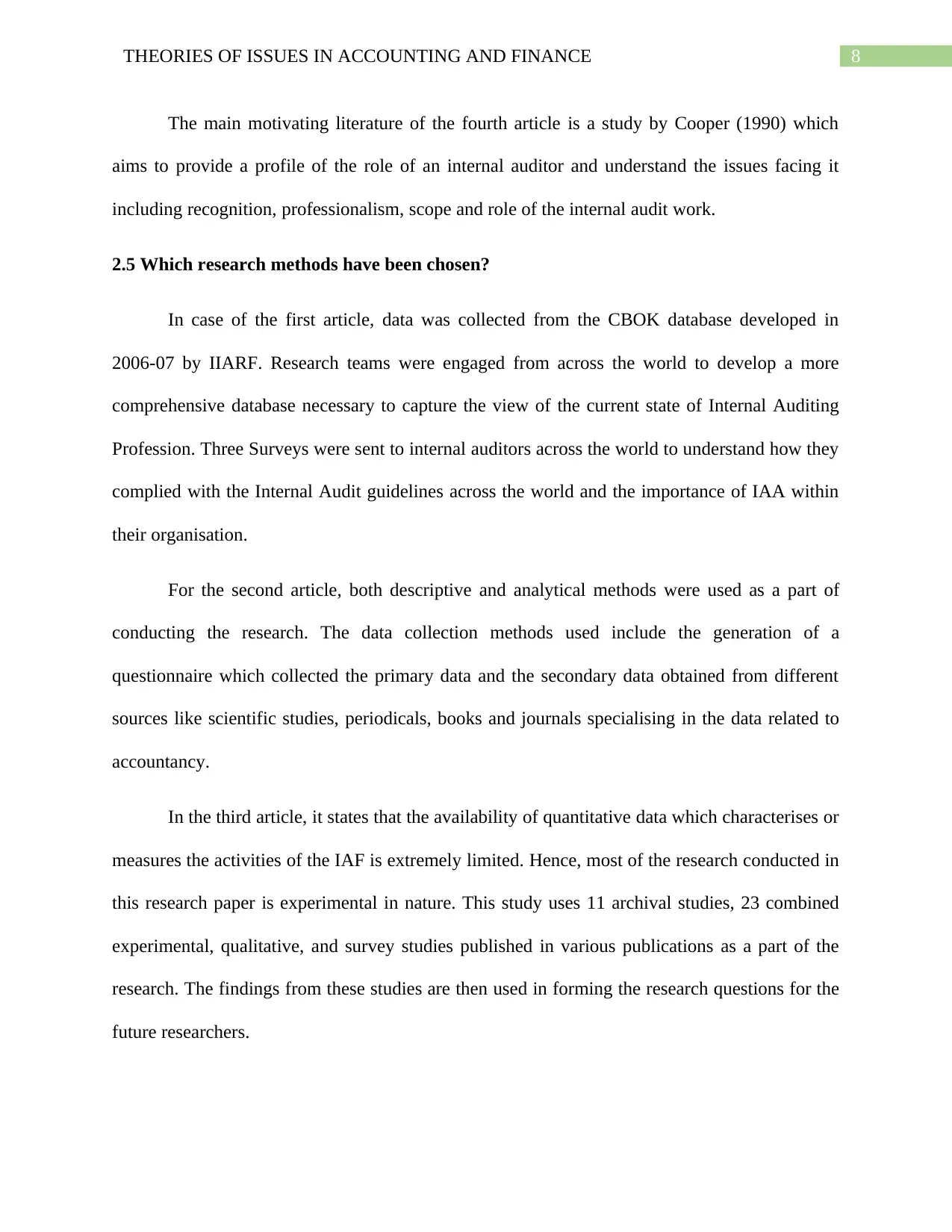
8THEORIES OF ISSUES IN ACCOUNTING AND FINANCE
The main motivating literature of the fourth article is a study by Cooper (1990) which
aims to provide a profile of the role of an internal auditor and understand the issues facing it
including recognition, professionalism, scope and role of the internal audit work.
2.5 Which research methods have been chosen?
In case of the first article, data was collected from the CBOK database developed in
2006-07 by IIARF. Research teams were engaged from across the world to develop a more
comprehensive database necessary to capture the view of the current state of Internal Auditing
Profession. Three Surveys were sent to internal auditors across the world to understand how they
complied with the Internal Audit guidelines across the world and the importance of IAA within
their organisation.
For the second article, both descriptive and analytical methods were used as a part of
conducting the research. The data collection methods used include the generation of a
questionnaire which collected the primary data and the secondary data obtained from different
sources like scientific studies, periodicals, books and journals specialising in the data related to
accountancy.
In the third article, it states that the availability of quantitative data which characterises or
measures the activities of the IAF is extremely limited. Hence, most of the research conducted in
this research paper is experimental in nature. This study uses 11 archival studies, 23 combined
experimental, qualitative, and survey studies published in various publications as a part of the
research. The findings from these studies are then used in forming the research questions for the
future researchers.
The main motivating literature of the fourth article is a study by Cooper (1990) which
aims to provide a profile of the role of an internal auditor and understand the issues facing it
including recognition, professionalism, scope and role of the internal audit work.
2.5 Which research methods have been chosen?
In case of the first article, data was collected from the CBOK database developed in
2006-07 by IIARF. Research teams were engaged from across the world to develop a more
comprehensive database necessary to capture the view of the current state of Internal Auditing
Profession. Three Surveys were sent to internal auditors across the world to understand how they
complied with the Internal Audit guidelines across the world and the importance of IAA within
their organisation.
For the second article, both descriptive and analytical methods were used as a part of
conducting the research. The data collection methods used include the generation of a
questionnaire which collected the primary data and the secondary data obtained from different
sources like scientific studies, periodicals, books and journals specialising in the data related to
accountancy.
In the third article, it states that the availability of quantitative data which characterises or
measures the activities of the IAF is extremely limited. Hence, most of the research conducted in
this research paper is experimental in nature. This study uses 11 archival studies, 23 combined
experimental, qualitative, and survey studies published in various publications as a part of the
research. The findings from these studies are then used in forming the research questions for the
future researchers.
⊘ This is a preview!⊘
Do you want full access?
Subscribe today to unlock all pages.

Trusted by 1+ million students worldwide
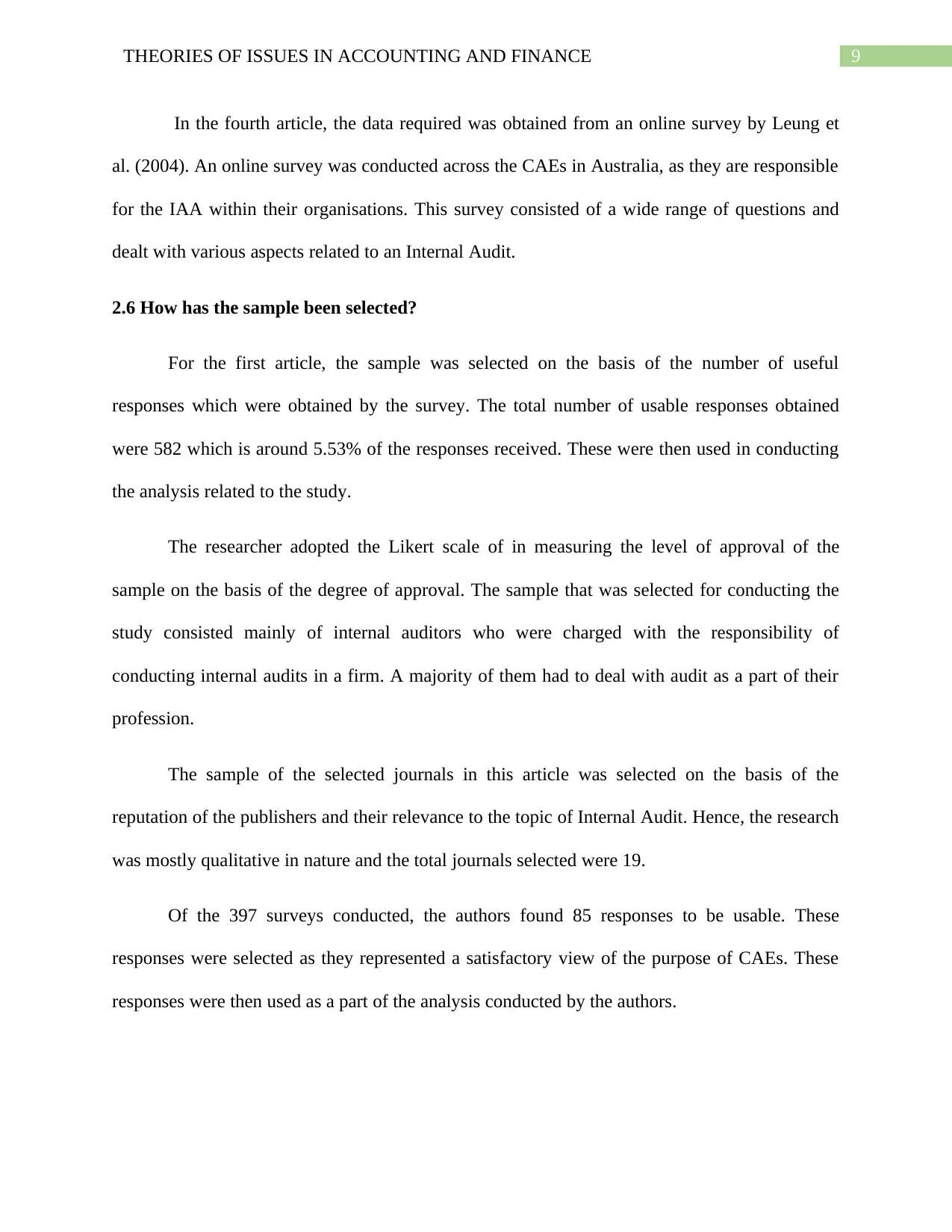
9THEORIES OF ISSUES IN ACCOUNTING AND FINANCE
In the fourth article, the data required was obtained from an online survey by Leung et
al. (2004). An online survey was conducted across the CAEs in Australia, as they are responsible
for the IAA within their organisations. This survey consisted of a wide range of questions and
dealt with various aspects related to an Internal Audit.
2.6 How has the sample been selected?
For the first article, the sample was selected on the basis of the number of useful
responses which were obtained by the survey. The total number of usable responses obtained
were 582 which is around 5.53% of the responses received. These were then used in conducting
the analysis related to the study.
The researcher adopted the Likert scale of in measuring the level of approval of the
sample on the basis of the degree of approval. The sample that was selected for conducting the
study consisted mainly of internal auditors who were charged with the responsibility of
conducting internal audits in a firm. A majority of them had to deal with audit as a part of their
profession.
The sample of the selected journals in this article was selected on the basis of the
reputation of the publishers and their relevance to the topic of Internal Audit. Hence, the research
was mostly qualitative in nature and the total journals selected were 19.
Of the 397 surveys conducted, the authors found 85 responses to be usable. These
responses were selected as they represented a satisfactory view of the purpose of CAEs. These
responses were then used as a part of the analysis conducted by the authors.
In the fourth article, the data required was obtained from an online survey by Leung et
al. (2004). An online survey was conducted across the CAEs in Australia, as they are responsible
for the IAA within their organisations. This survey consisted of a wide range of questions and
dealt with various aspects related to an Internal Audit.
2.6 How has the sample been selected?
For the first article, the sample was selected on the basis of the number of useful
responses which were obtained by the survey. The total number of usable responses obtained
were 582 which is around 5.53% of the responses received. These were then used in conducting
the analysis related to the study.
The researcher adopted the Likert scale of in measuring the level of approval of the
sample on the basis of the degree of approval. The sample that was selected for conducting the
study consisted mainly of internal auditors who were charged with the responsibility of
conducting internal audits in a firm. A majority of them had to deal with audit as a part of their
profession.
The sample of the selected journals in this article was selected on the basis of the
reputation of the publishers and their relevance to the topic of Internal Audit. Hence, the research
was mostly qualitative in nature and the total journals selected were 19.
Of the 397 surveys conducted, the authors found 85 responses to be usable. These
responses were selected as they represented a satisfactory view of the purpose of CAEs. These
responses were then used as a part of the analysis conducted by the authors.
Paraphrase This Document
Need a fresh take? Get an instant paraphrase of this document with our AI Paraphraser
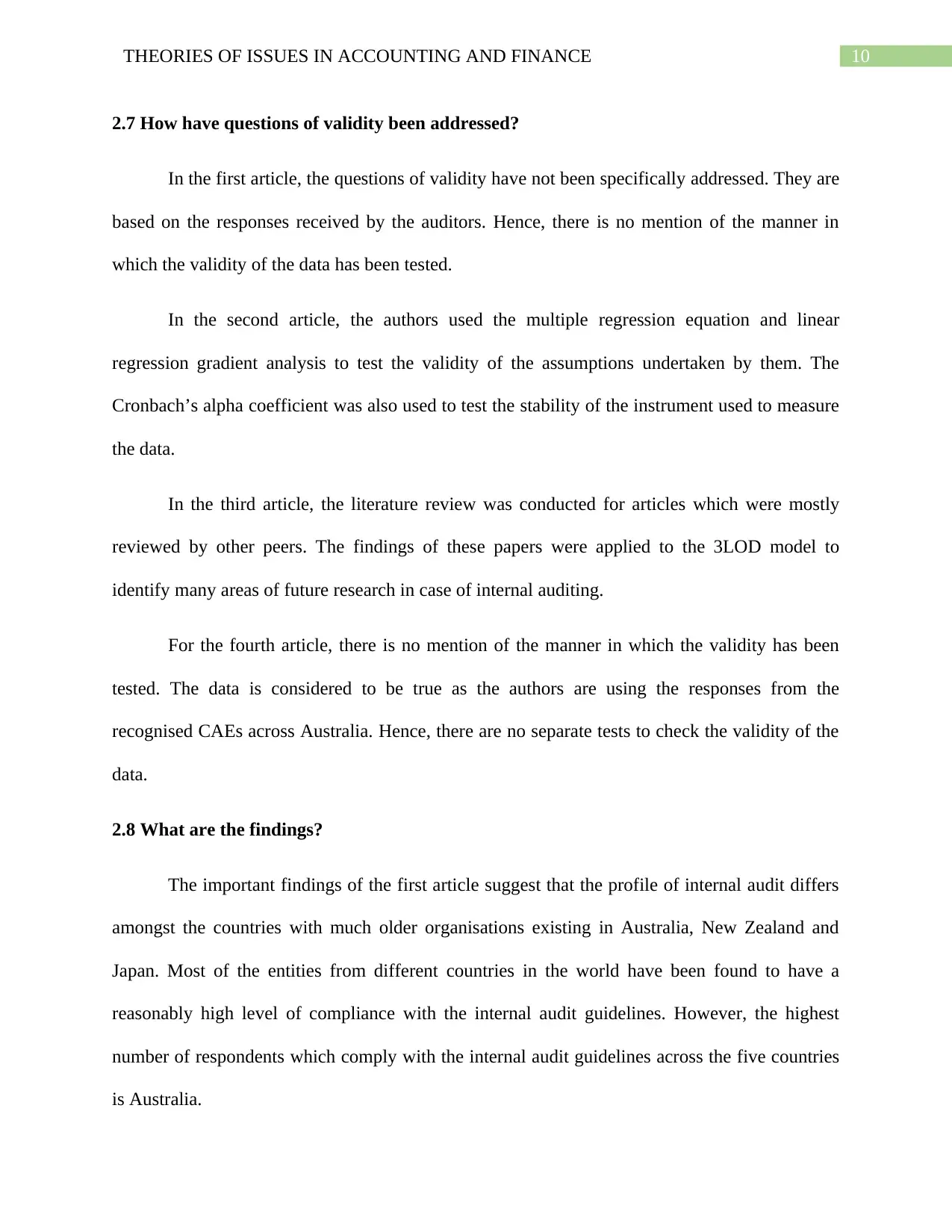
10THEORIES OF ISSUES IN ACCOUNTING AND FINANCE
2.7 How have questions of validity been addressed?
In the first article, the questions of validity have not been specifically addressed. They are
based on the responses received by the auditors. Hence, there is no mention of the manner in
which the validity of the data has been tested.
In the second article, the authors used the multiple regression equation and linear
regression gradient analysis to test the validity of the assumptions undertaken by them. The
Cronbach’s alpha coefficient was also used to test the stability of the instrument used to measure
the data.
In the third article, the literature review was conducted for articles which were mostly
reviewed by other peers. The findings of these papers were applied to the 3LOD model to
identify many areas of future research in case of internal auditing.
For the fourth article, there is no mention of the manner in which the validity has been
tested. The data is considered to be true as the authors are using the responses from the
recognised CAEs across Australia. Hence, there are no separate tests to check the validity of the
data.
2.8 What are the findings?
The important findings of the first article suggest that the profile of internal audit differs
amongst the countries with much older organisations existing in Australia, New Zealand and
Japan. Most of the entities from different countries in the world have been found to have a
reasonably high level of compliance with the internal audit guidelines. However, the highest
number of respondents which comply with the internal audit guidelines across the five countries
is Australia.
2.7 How have questions of validity been addressed?
In the first article, the questions of validity have not been specifically addressed. They are
based on the responses received by the auditors. Hence, there is no mention of the manner in
which the validity of the data has been tested.
In the second article, the authors used the multiple regression equation and linear
regression gradient analysis to test the validity of the assumptions undertaken by them. The
Cronbach’s alpha coefficient was also used to test the stability of the instrument used to measure
the data.
In the third article, the literature review was conducted for articles which were mostly
reviewed by other peers. The findings of these papers were applied to the 3LOD model to
identify many areas of future research in case of internal auditing.
For the fourth article, there is no mention of the manner in which the validity has been
tested. The data is considered to be true as the authors are using the responses from the
recognised CAEs across Australia. Hence, there are no separate tests to check the validity of the
data.
2.8 What are the findings?
The important findings of the first article suggest that the profile of internal audit differs
amongst the countries with much older organisations existing in Australia, New Zealand and
Japan. Most of the entities from different countries in the world have been found to have a
reasonably high level of compliance with the internal audit guidelines. However, the highest
number of respondents which comply with the internal audit guidelines across the five countries
is Australia.
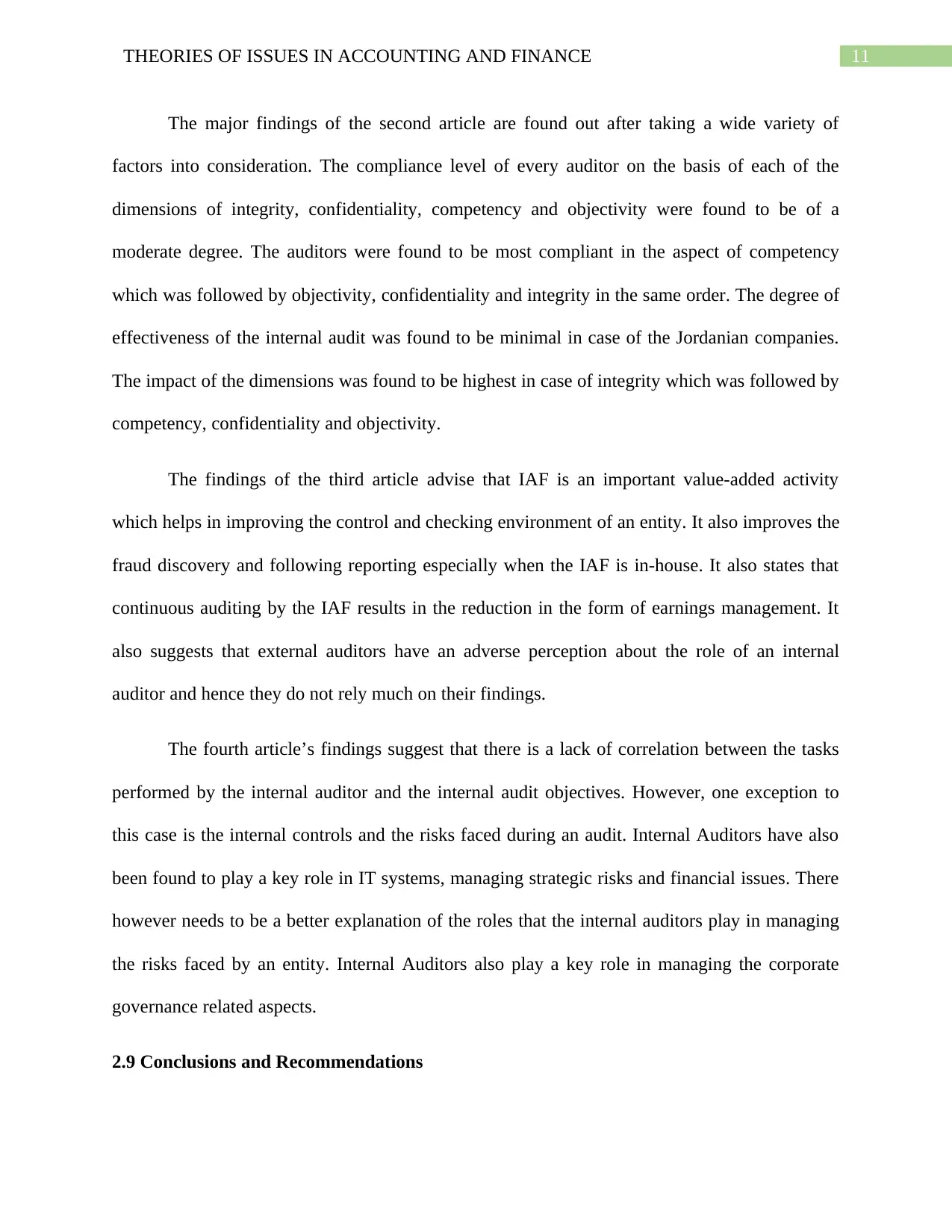
11THEORIES OF ISSUES IN ACCOUNTING AND FINANCE
The major findings of the second article are found out after taking a wide variety of
factors into consideration. The compliance level of every auditor on the basis of each of the
dimensions of integrity, confidentiality, competency and objectivity were found to be of a
moderate degree. The auditors were found to be most compliant in the aspect of competency
which was followed by objectivity, confidentiality and integrity in the same order. The degree of
effectiveness of the internal audit was found to be minimal in case of the Jordanian companies.
The impact of the dimensions was found to be highest in case of integrity which was followed by
competency, confidentiality and objectivity.
The findings of the third article advise that IAF is an important value-added activity
which helps in improving the control and checking environment of an entity. It also improves the
fraud discovery and following reporting especially when the IAF is in-house. It also states that
continuous auditing by the IAF results in the reduction in the form of earnings management. It
also suggests that external auditors have an adverse perception about the role of an internal
auditor and hence they do not rely much on their findings.
The fourth article’s findings suggest that there is a lack of correlation between the tasks
performed by the internal auditor and the internal audit objectives. However, one exception to
this case is the internal controls and the risks faced during an audit. Internal Auditors have also
been found to play a key role in IT systems, managing strategic risks and financial issues. There
however needs to be a better explanation of the roles that the internal auditors play in managing
the risks faced by an entity. Internal Auditors also play a key role in managing the corporate
governance related aspects.
2.9 Conclusions and Recommendations
The major findings of the second article are found out after taking a wide variety of
factors into consideration. The compliance level of every auditor on the basis of each of the
dimensions of integrity, confidentiality, competency and objectivity were found to be of a
moderate degree. The auditors were found to be most compliant in the aspect of competency
which was followed by objectivity, confidentiality and integrity in the same order. The degree of
effectiveness of the internal audit was found to be minimal in case of the Jordanian companies.
The impact of the dimensions was found to be highest in case of integrity which was followed by
competency, confidentiality and objectivity.
The findings of the third article advise that IAF is an important value-added activity
which helps in improving the control and checking environment of an entity. It also improves the
fraud discovery and following reporting especially when the IAF is in-house. It also states that
continuous auditing by the IAF results in the reduction in the form of earnings management. It
also suggests that external auditors have an adverse perception about the role of an internal
auditor and hence they do not rely much on their findings.
The fourth article’s findings suggest that there is a lack of correlation between the tasks
performed by the internal auditor and the internal audit objectives. However, one exception to
this case is the internal controls and the risks faced during an audit. Internal Auditors have also
been found to play a key role in IT systems, managing strategic risks and financial issues. There
however needs to be a better explanation of the roles that the internal auditors play in managing
the risks faced by an entity. Internal Auditors also play a key role in managing the corporate
governance related aspects.
2.9 Conclusions and Recommendations
⊘ This is a preview!⊘
Do you want full access?
Subscribe today to unlock all pages.

Trusted by 1+ million students worldwide
1 out of 17
Related Documents
Your All-in-One AI-Powered Toolkit for Academic Success.
+13062052269
info@desklib.com
Available 24*7 on WhatsApp / Email
![[object Object]](/_next/static/media/star-bottom.7253800d.svg)
Unlock your academic potential
Copyright © 2020–2025 A2Z Services. All Rights Reserved. Developed and managed by ZUCOL.



